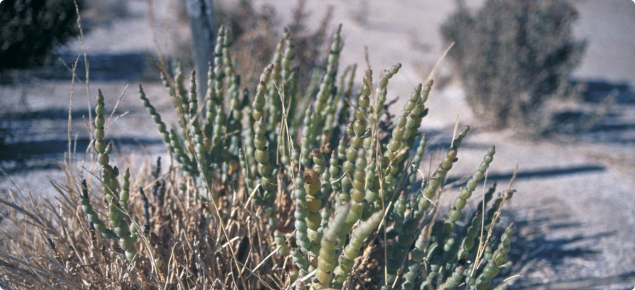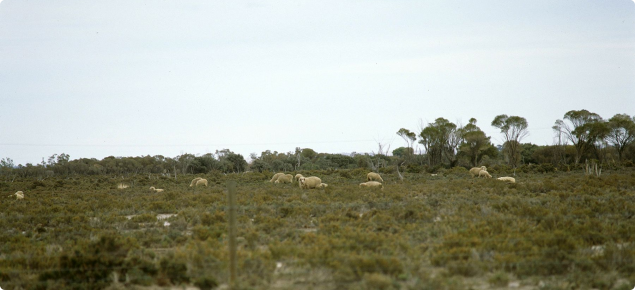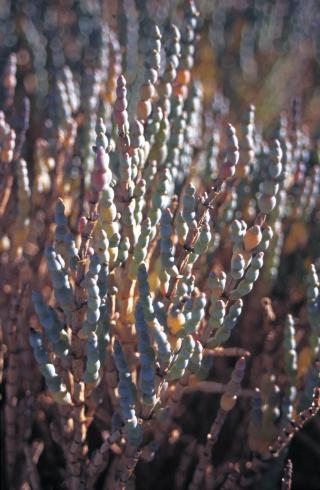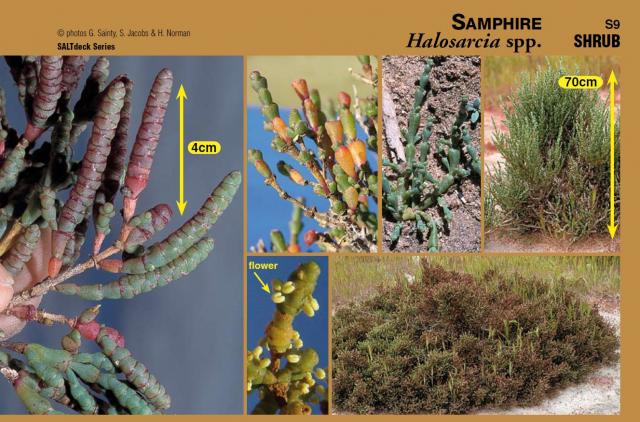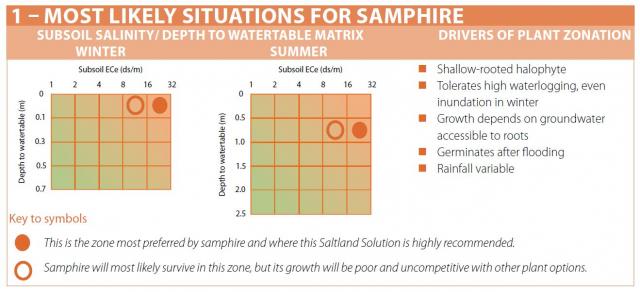Family: Chenopodiaceae
There are 65 Tecticornia taxa, all native to Australia (see FloraBase). Note that samphire was previously genus Halosarcia: some of the linked pages and information still refer to Halosarcia.
Description
Samphires are perennial shrubs, with either a spreading or a more erect habit, up to 1 metre high. Branches comprise succulent, hairless stem segments (Figure 1), varying in colour from green to red-purple. Flowering is mostly in summer to autumn, depending on the site latitude.
Flowers and seeds are minute and hidden between the fleshy segments (Figure 2). The seed is small (less than one millimetre in diameter) and may be brown or black, depending on the species. Locate seeds by splitting or rubbing the ripe segment. Seeds mature in late summer but the fleshy seed heads may not dry off until autumn.
Occurrence
Samphires grow in intermittently flooded, saline land. They are widespread inland, and along coasts, estuaries and the margins of salt lakes. They generally form the first fringing community adjacent to the bare margins of salt lakes, and are found in many drainages in Australia’s pastoral and agricultural areas.
Suitable sites for samphire
Matching plants to a saline site
Tecticornia species differ in their salinity and waterlogging tolerance (Figure 3). The species commonly found on salt flats in WA (Tecticornia pergranulata pergranulata) will withstand months of waterlogging and weeks of inundation and total submergence. However, there are samphire species that grow on well-drained banks around saltland (e.g. T. indica), and these plants are likely to be more sensitive to inundation.
A study of samphire zonation in WA found that different species selected positions in the landscape primarily in response to soil moisture and salt load. Soil pH played a small role.
The presence of samphire on a site is a good indicator that the area is too waterlogged or salty for economically viable planting of more productive species (Figure 4).
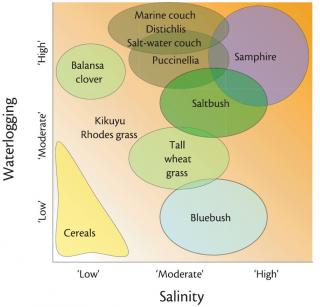
Most samphires are able to tolerate hypersaline, alkaline and waterlogged soils. They are good pioneer plants for severely saline land reclamation.
Waterlogging/inundation
Samphires can grow in soils that are more or less permanently waterlogged, and some species can withstand up to six months’ partial inundation.
Salinity
Samphires are highly salt-tolerant once established. Specimens growing on salt flats near Kalgoorlie in Western
Australia (WA) have been able to withstand extreme salinity, with measured soil ECe values of 7000 to 10 000mS/m at depths of 10–20 cm over summer. At Wubin in WA, samphire growing in the Sustainable Grazing on Saline Land experiments had ECe values of ~4000 mS/m at 0–25 cm depth in spring. Seawater is typically about 5500 mS/m.
The plants adapt to salinity by storing salt in the vacuoles of their fleshy stem segments, and can have salt concentrations of 30–45%.
Samphire is a typical halophyte. In solution cultures, its pattern of growth is lower when salinity is low, increasing to an optimum with an EC in the solution of ~2000 mS/m. Growth then gradually declines as concentrations reach 8000 mS/m.
Climate
Samphires are endemic across southern Australia and therefore are well adapted to the temperature and rainfall conditions in almost all areas where dryland salinity occurs in the southern states. Germination appears to be temperature responsive: of a range of temperatures tested, optimal germination occurred with a day/night regime of 5–35°C.
Grazing value of samphire
We recommend that you do not graze samphire dominant areas.
Reasons for not grazing samphire:
- Salt concentrations in the forage can reach 40%, and this will limit all feed intake.
- If grazed, it must be in conjunction with other feed (stubble or dry annual pastures) to dilute salt intake and provide adequate energy.
- There are likely to be other, anti-nutritional factors.
- Samphire is susceptible to trampling by stock, and
- There is an increased livestock requirement for fresh water.
It is relatively safe to graze samphires as a minor component in mixed-species saltland pastures. Samphire shrubs survive moderate grazing, and young plants appear to be palatable.
Interesting content of samphires
Samphires have high concentrations of glycine betaine, used in salinity regulation. Betaine is sold through many market segments: pharmaceuticals, cosmetics, health foods, and plant sprays to increase drought tolerance. However, there are other, more commercial sources of betaine.
Other potential uses of samphire
Have you tried samphire in salads, or pickled samphire? These are not common uses, but here is something for you to try:
From 'The cook and the chef’ on ABC TV in August 2006:
“Samphire is a native succulent. Woody at the base and with many branches, it grows freely on many of southern Australia’s salty flats. Samphire is considered best for use in summer when the fleshy leaves are bright green and aromatic. In winter, the leaves turn a reddish/ pink but, as Simon discovered, there is still some green to be found at the base of the plants. Simon also finds that blanching winter samphire before cooking gives him the lovely, salty taste of the sea that he’s after for his dishes.”
See Native tastes of Australia – samphire for another way to use this plant.
Pickled samphire: Samphire, salt, vinegar
Gather the young and green samphire at the beginning of summer, before it flowers and sets seed. Break into 5 cm lengths, lay on a dish and sprinkle with dry salt. Leave for 24 hours. Drain, then cook gently – in enough vinegar to just cover it – until tender, but do not allow it to get soft. Plain vinegar is best for this, as the samphire has its own spicy flavour. Seal securely in hot jars.
Managing samphire
Establishing by natural spread
We recommend establishing samphire on suitable saline land by fencing the area and letting nature take its course.
For the most salt tolerant samphire species, germination can occur at salinities up to ~4000 mS/m.
Samphire rapidly spreads when protected from grazing. It may occupy sites capable of growing more useful saltland pasture species. Tickling the soil surface with a scarifier can also help create seed niches.
Establishing by spreading collected seed
Identify local sites with similar levels of waterlogging and salinity from which to collect seed . The best time to collect and spread the appropriate samphire species across a site is in autumn after flowering and seed set.
The two options are:
- Harvest the shoots or whole plants by hand or with a forage harvester, and spread the harvested material on new site, and
- Harvest green mature seed heads in late summer, dry the seed heads, then broadcast the dried material onto scarified soil before the first autumn rains.
As different species can tolerate different conditions, seed should be sourced from local sites with similar salinity/waterlogging profiles for best results.
Under controlled conditions, seed germination is affected by soil salinity, temperature and seed scarification. In practical terms, samphires will germinate in spring after soils have been leached by rainfall and/or floodwaters.
Natural thickening of samphire stands
Once some samphire has been established on a site, the stands may be thickened by cultivating bare areas to encourage soil leaching and create niches in which seeds can lodge.
There is no need to worry about weed control on sites suited to this saltland solution. With the levels of salinity and waterlogging present, weeds have little chance of establishing and, if they do, that is good in the short term.
Resources
Bhuiyan Mohammad SI, Maynard, G, Raman, A, Hodgkins, D, Mitchell, D & Nicol, H, 2016, 'Salt effects on proline and glycine betaine levels and photosynthetic performance in Melilotus siculus, Tecticornia pergranulata and Thinopyrum ponticum measured in simulated saline conditions', Functional Plant Biology, vol. 43, pp. 254–265.

